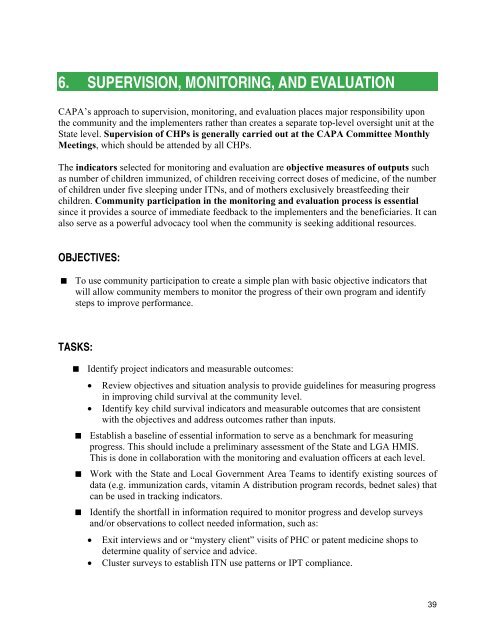The CAPA Handbook: A "How-to" Guide for Implementing ... - basics
The CAPA Handbook: A "How-to" Guide for Implementing ... - basics
The CAPA Handbook: A "How-to" Guide for Implementing ... - basics
Create successful ePaper yourself
Turn your PDF publications into a flip-book with our unique Google optimized e-Paper software.
6. SUPERVISION, MONITORING, AND EVALUATION<br />
<strong>CAPA</strong>’s approach to supervision, monitoring, and evaluation places major responsibility upon<br />
the community and the implementers rather than creates a separate top-level oversight unit at the<br />
State level. Supervision of CHPs is generally carried out at the <strong>CAPA</strong> Committee Monthly<br />
Meetings, which should be attended by all CHPs.<br />
<strong>The</strong> indicators selected <strong>for</strong> monitoring and evaluation are objective measures of outputs such<br />
as number of children immunized, of children receiving correct doses of medicine, of the number<br />
of children under five sleeping under ITNs, and of mothers exclusively breastfeeding their<br />
children. Community participation in the monitoring and evaluation process is essential<br />
since it provides a source of immediate feedback to the implementers and the beneficiaries. It can<br />
also serve as a powerful advocacy tool when the community is seeking additional resources.<br />
OBJECTIVES:<br />
■<br />
To use community participation to create a simple plan with basic objective indicators that<br />
will allow community members to monitor the progress of their own program and identify<br />
steps to improve per<strong>for</strong>mance.<br />
TASKS:<br />
■<br />
■<br />
■<br />
■<br />
Identify project indicators and measurable outcomes:<br />
• Review objectives and situation analysis to provide guidelines <strong>for</strong> measuring progress<br />
in improving child survival at the community level.<br />
• Identify key child survival indicators and measurable outcomes that are consistent<br />
with the objectives and address outcomes rather than inputs.<br />
Establish a baseline of essential in<strong>for</strong>mation to serve as a benchmark <strong>for</strong> measuring<br />
progress. This should include a preliminary assessment of the State and LGA HMIS.<br />
This is done in collaboration with the monitoring and evaluation officers at each level.<br />
Work with the State and Local Government Area Teams to identify existing sources of<br />
data (e.g. immunization cards, vitamin A distribution program records, bednet sales) that<br />
can be used in tracking indicators.<br />
Identify the shortfall in in<strong>for</strong>mation required to monitor progress and develop surveys<br />
and/or observations to collect needed in<strong>for</strong>mation, such as:<br />
• Exit interviews and or “mystery client” visits of PHC or patent medicine shops to<br />
determine quality of service and advice.<br />
• Cluster surveys to establish ITN use patterns or IPT compliance.<br />
39

















